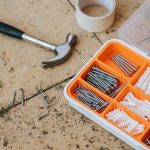Are you tired of seeing those unsightly tears and scratches on your leather look fabric sofa? Don’t worry, we’ve got you covered!
In this article, we will guide you through the step-by-step process of repairing your sofa, so you can have it looking as good as new in no time.
By following our simple instructions and using the right tools, you’ll be able to tackle any damage with ease.
So, let’s get started and bring back the beauty of your sofa!
Table of Contents
Assessing the Damage
First, take a close look at the sofa to see the extent of the damage. Assessing the damage is an important step in repairing your leather look fabric sofa. Start by examining the surface of the sofa to identify any visible tears, scratches, or discoloration. Look for any areas where the fabric may be peeling or coming loose from the frame. Take note of the size and location of each damaged area.
Next, it is crucial to identify the cause of the damage. Was it accidental, such as a spill or pet scratch? Or is it due to regular wear and tear? Understanding the cause will help you determine the best course of action for repairing the sofa.
Once you have assessed the damage and identified the cause, you can proceed with the necessary repairs. Whether it’s applying a leather repair kit, patching up torn areas, or using fabric dye to restore color, it’s important to have a clear plan in place. Remember to follow the instructions carefully and take your time to ensure a successful repair.
Assessing the damage and identifying the cause are crucial first steps in repairing your leather look fabric sofa. By understanding the extent of the damage and the underlying cause, you can effectively plan and execute the necessary repairs for a restored and rejuvenated sofa.
Gathering the Necessary Tools
Before you get started, make sure you have all the tools you’ll need. Repairing leather look fabric on your sofa is a simple process if you have the right materials at hand.
Here are three essential items you’ll need:
-
Choosing the right repair kit: Look for a repair kit specifically designed for leather look fabric. These kits usually contain color-matching compounds, adhesive, and tools to help you repair any damage effectively. Read reviews and choose a reputable brand to ensure the best results.
-
Identifying the type of leather look fabric: Before you start repairing, it’s important to understand the type of leather look fabric you’re working with. Different types of fabric may require different repair techniques or materials. Check the manufacturer’s label or consult a professional to determine the exact type of fabric.
-
Cleaning supplies: Before you begin the repair process, make sure to clean the damaged area thoroughly. Use a mild detergent and a soft cloth to remove any dirt or grime. This will ensure a clean surface for the repair materials to adhere to.
Cleaning and Preparing the Surface
To ensure a successful repair, start by thoroughly cleaning and preparing the damaged area with mild detergent and a soft cloth.
Begin by gently removing any loose dirt or debris from the surface of the fabric. Use a vacuum cleaner or a soft brush to sweep away any crumbs or particles.
Next, dampen the soft cloth with mild detergent mixed with warm water. Gently scrub the stained area in a circular motion, being careful not to apply too much pressure. Rinse the cloth frequently and continue to scrub until the stain is lifted.
Once the stain is removed, rinse the area with clean water and use a dry cloth to absorb any excess moisture. Allow the fabric to air dry completely before proceeding with the repair.
Filling and Repairing Small Tears or Scratches
When it comes to repairing small tears or filling scratches on your leather look fabric sofa, there are a few key points to keep in mind.
First, make sure you have the right materials and tools on hand, such as a leather repair kit and a soft cloth.
Next, carefully clean the affected area before applying any repairs, using a mild soap and water solution.
Repairing Small Tears
You can easily repair small tears in your leather look fabric sofa using a leather repair kit. Assess the size of the tear to determine the best approach for repair. If the tear is small, you can follow these steps to fix it:
- Clean the area around the tear with a mild soap and water solution.
- Trim any loose threads or frayed edges around the tear using sharp scissors.
- Apply a thin layer of adhesive from the leather repair kit to the edges of the tear, ensuring that the adhesive is evenly spread.
- Gently press the edges of the tear together to seal it.
- Allow the adhesive to dry completely before using the sofa again.
Filling Scratches Effectively
Using a scratch filler is an effective way to restore the appearance of your sofa. Whether your sofa is made of leather or leather-look fabric, scratches can be unsightly and diminish the overall look of your furniture. Fortunately, there are effective techniques that can help you fill those scratches and make your sofa look as good as new.
To start, choose a scratch filler that matches the color of your sofa. Apply the filler to the scratched area and use a soft cloth to blend it in. Be sure to follow the instructions provided by the manufacturer for best results.
If you are unsure about filling the scratches on your own, don’t hesitate to seek professional assistance. A professional can provide expert advice and ensure that the scratches are filled properly, resulting in a seamless and professional finish.
Patching Larger Damaged Areas
To patch larger damaged areas on your leather look fabric sofa, start by gathering the necessary materials. You will need a patch kit that includes a piece of matching color fabric, adhesive, and a spatula or scraper. Additionally, have a pair of scissors, a cloth, and rubbing alcohol on hand.
| Materials |
|---|
| Patch Kit |
| Scissors |
| Cloth |
| Rubbing Alcohol |
| Spatula or Scraper |
Before beginning the patching process, clean the damaged area with rubbing alcohol and a cloth to remove any dirt or oils. This will help ensure proper adhesion of the patch.
Next, cut the patch fabric to a size slightly larger than the damaged area. This will allow for better coverage and blending. Apply a thin layer of adhesive to the back of the patch and carefully position it over the damaged area. Use the spatula or scraper to smooth out any air bubbles and ensure a secure bond.
Allow the adhesive to dry according to the instructions on the patch kit. Once dry, gently buff the patched area with a cloth to blend it with the rest of the sofa.
While patching larger damaged areas can be done at home, for more complex repairs or if you are unsure of your abilities, it is always advisable to seek professional assistance. They have the expertise and tools to ensure a seamless and long-lasting repair.
Blending the Repair With the Surrounding Fabric
Now that you’ve successfully patched the larger damaged areas on your leather look fabric sofa, the next step is to blend the repair with the surrounding fabric. This is crucial to ensure that the repaired area seamlessly matches the rest of the sofa, creating a uniform and visually appealing look.
To achieve a perfect blend, you’ll need to focus on two key aspects: blending techniques and color matching. Blending techniques involve using various tools and methods to create a smooth transition between the repaired area and the surrounding fabric. This can include using sandpaper, heat guns, or even specialized blending agents to soften the edges and texture of the repair.
Color matching is equally important in achieving a seamless repair. You want the color of the repaired area to match the original fabric as closely as possible. This may involve obtaining a color swatch or sample from the manufacturer or using specialized leather dyes or paints to achieve a precise color match. Take your time during this step, as getting the color just right is crucial for a successful repair.
Applying a Protective Finish
When it comes to protecting your leather look fabric sofa, applying a protective finish is of utmost importance. By doing so, you can safeguard the fabric from stains, spills, and everyday wear and tear.
This process not only enhances the longevity of your sofa but also ensures that it maintains its pristine appearance for years to come.
Importance of Protection
Protecting your leather look fabric sofa is crucial to maintaining its longevity and appearance. By implementing effective protection techniques, you can prevent damage and extend the lifespan of your sofa. Here are some benefits of prevention:
-
Shielding against spills and stains:
-
Applying a protective finish helps create a barrier that repels liquids, making it easier to clean up any accidental spills without leaving permanent marks.
-
Regularly using a fabric protector spray can also minimize the absorption of stains, ensuring your sofa stays looking fresh and clean.
-
Guarding against wear and tear:
-
Covering your sofa with a slipcover or using armrest covers can provide an extra layer of protection against everyday wear and tear, such as scratches, scuffs, and fading.
-
Placing a throw blanket on high-traffic areas can also help distribute weight evenly and prevent excessive friction, preserving the fabric’s integrity.
Taking preventive measures to protect your leather look fabric sofa not only enhances its durability but also maintains its aesthetic appeal.
Applying the Finish
To maintain the longevity and appearance of your sofa, you should apply a protective finish. Applying the finish is an essential step in protecting the fabric from spills, stains, and wear and tear. It creates a barrier that repels liquids and prevents them from seeping into the fabric fibers.
The protective finish also helps to maintain the color and texture of the fabric, preventing it from fading or becoming dull over time. When applying the finish, it is important to follow the manufacturer’s instructions and use a clean, soft cloth or sponge. Apply the finish evenly and allow it to dry completely before using the sofa.
Regularly reapplying the finish will ensure that your sofa stays protected and looking its best for years to come.
Long-Lasting Durability
In order to ensure that your sofa lasts for years, it’s important to choose a durable and high-quality fabric. Here are some longevity tips and maintenance techniques to keep your sofa looking and feeling great:
- Regularly vacuum your sofa to remove dust and dirt buildup.
- Avoid placing your sofa in direct sunlight to prevent fading and damage.
- Clean spills immediately with a gentle upholstery cleaner to prevent stains from setting.
- Rotate cushions and flip them periodically to distribute wear evenly.
By following these simple tips, you can extend the lifespan of your sofa and keep it looking as good as new.
Maintaining and Caring for the Repaired Sofa
You’ll want to regularly clean and condition the repaired sofa to keep it looking its best. Here are some maintaining tips to prevent future damage and ensure the longevity of your leather look fabric sofa.
Firstly, make sure to vacuum your sofa regularly using a soft brush attachment to remove any dust or debris. This will help prevent the build-up of dirt and keep the fabric looking fresh. Additionally, wipe down the sofa with a damp cloth to remove any spills or stains immediately. Avoid using harsh chemicals or abrasive cleaners as they can damage the fabric.
To prevent future damage, it’s essential to keep your sofa away from direct sunlight and heat sources. Prolonged exposure to these elements can cause the fabric to fade or crack over time. Consider using curtains or blinds to shield your sofa from the sun’s rays.
Furthermore, avoid placing sharp objects or pets on your sofa as they can scratch or puncture the fabric. If you have pets, it’s a good idea to use protective covers or throws to minimize damage from their claws.
Lastly, consider applying a protective spray or cream to your sofa to enhance its resistance to stains and spills. Follow the manufacturer’s instructions carefully when using these products.
Conclusion
In conclusion, repairing a leather look fabric sofa is a straightforward process that can be done at home with the right tools and techniques.
By carefully assessing the damage, gathering the necessary tools, cleaning and preparing the surface, and filling in small tears or scratches, you can restore your sofa to its former glory.
Don’t forget to patch larger damaged areas and blend the repair with the surrounding fabric for a seamless finish.
Apply a protective finish and regularly maintain and care for your repaired sofa to ensure its longevity.
- How Does Ring Spun Cotton Affect Garment Fit and Shape Retention? - August 13, 2024
- What Are the Challenges in Producing Ring Spun Cotton? - August 13, 2024
- Is Ring Spun Cotton Suitable for Plus-Size Clothing? - August 13, 2024






